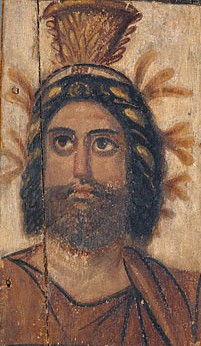Thomas F. Mathews says that Christian icons “…grew out of a strong tradition of pagan panel paintings of the ancient gods…” (p. 179) Mathews points to some glaring examples of this transfer from paganism to eastern Christianity.
…a fresco painted directly on a house wall in Karanis to serve as a permanent icon shows the enthroned Isis nursing Harpocrates. The enthroned Mother of God with the Christ Child in her lap is one of the most popular of all Christian icon types, and three early examples are known. The Sinai icon transforms the wood throne of Isis into a massive golden throne with a high cushion, and it copies the engaging gaze of both mother and child. Out of modesty, however, it refrains from showing the naked breasts of the goddess. (p. 182)


The second example cited by Mathews is that of Jesus, which has influenced our image of him down to the present day.
Icons of Christ himself also offer a remarkable demonstration of the authority of pagan sacred images. Among the sixth-century icons at Sinai, three very different types of Christ’s face can be observed: a young-man type with a rather triangular head, short hair reaching only to the ears and a short beard; an old-man type with long white hair and pointed beard; and the Blessing Christ, commonly called the Pantocrator type, first witnessed in the famous Sinai icon. It is this last type, adapted in coinage and monumental mosaics, that eventually came to predominate, determining our notion of the savior down to modern times. Here a Christ with broad forehead and heavy neck wears a great mass of dark hair and a full but fairly short beard. The potency of this type had nothing to do with its portrait accuracy; it was more potent because of its divine pagan associations with the father of the gods.
In Antiquity, the Jupiter facial type was adopted by a number of the most potent male gods, including Neptune, Asclepius, Serapis, and Suchos. The Getty Museum panel of Serapis illustrates this borrowing. Especially cultivated in Alexandria, where his Serapeum was one of the greatest shrines of the ancient world, Serapis united in himself the underworld powers of Osiris with the healing powers of Asclepius. His head is given the broad bow and copious hair of Jupiter; he wears a wreath of laurel and balances a modius or grain measure, on his head. […]
Similarly, Christians were conscious of the connection of some of their images of Christ with Jupiter, and they saw this as a danger. In the time of Bishop Gennadius of Constantinople (458—71) “a painter who dared to paint the Savior in the likeness of Zeus” found his hand withered. The bishop healed him and instructed him that “the other form of Christ, that is the one with short, frizzy hair, is the more authentic.” Historically, Gennadius was probably closer to the truth as far as first century hair styles were concerned, but the Jupiter type came to win out because it was the more forceful. Christ stole the look of the gods with whom he was in competition (pages 183—186).

